You may already know that phonological awareness refers to the awareness of sounds in words (no letters involved), while phonics deals with the relationships between sounds and letters.
Both phonological awareness and phonics are essential to helping students learn to read!
While these terms refer to 2 different things and are often taught through different types of activities, our phonological awareness and phonics instruction also need to be connected to each other.
When you intentionally connect your phonological awareness and phonics instruction, your students will progress even more quickly in their reading!
In this blog post, I’ll explain why they need to be connected, as well as how, specifically, to connect your phonics and phonological awareness instruction!
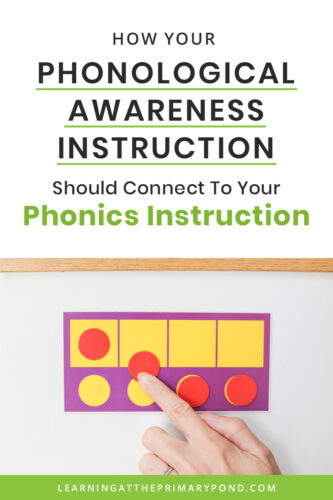
Why Should I Connect My Phonological Awareness and Phonics Instruction?
Some schools have a phonological awareness program that’s separate from their phonics or reading program. You might, for example, spend 10 minutes on phonological awareness drills from one program – and then later teach a 20-30 minute phonics lesson from a different program.
That’s not necessarily a bad thing, but students progress more quickly in their phonics and reading if you intentionally connect phonological awareness activities to your phonics instruction.
Here’s an example:
A 1st grade teacher knows that she will be teaching consonant blends in a few weeks. Students will be learning to read and spell words like “flip,” “drag,” “stem,” etc.
This teacher knows that some students will struggle to hear all of the sounds in words with consonant blends. They are accustomed to working with CVC words with only 3 sounds.
To help prepare students for their work with consonant blends, 2-3 weeks prior to starting her phonics instruction on words with blends, the teacher begins phonological awareness drills with consonant blends.
In these drills, students first learn to blend the sounds in words with consonant blends. For example, the teacher might say /s/ /p/ /ŏ/ /t/ and students say the entire word, spot.
After some practice with blending, the teacher begins having students segment words with consonant blends. The teacher might say “flag” and students must segment: /f/ /l/ /ă/ /g/ (perhaps with the teacher using sound boxes for support).
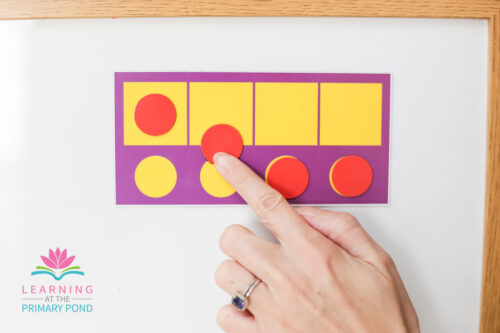
These activities prepare students to work with words with consonant blends – but right now, the kids are only working with sounds.
After 2-3 weeks, the teacher begins her phonics instruction on words with consonant blends.
Since students have already practiced working with the sounds in these words, it’s easier for them to read and write words with consonant blends. However, when the teacher asks them to write or build words with consonant blends, she still has them practice segmenting the word before they write or make it. Phonological awareness practice continues, so students get more practice blending and segmenting words with consonant blends.
Do you see how, in this example, the teacher prepared students to be more successful with their phonics work by using related phonological awareness drills prior to phonics instruction on those skills?
This can be applied to many, many skills – including but not limited to:
- CVC words – blending, segmenting
- Words with digraphs – blending, segmenting
- Glued sounds – blending, segmenting (to learn more about teaching glued sounds, check out this blog post)
- R-controlled vowels – blending, segmenting
- Long vowel words – blending, segmenting, identifying the vowel sound, changing the vowel sound
- Diphthongs – blending, segmenting, identifying the diphthong sound, changing the diphthong sound
How Can I Connect My Phonological Awareness and Phonics Instruction?
Now let’s talk about how to make this happen in your classroom!
The easiest way is to use a program that intentionally connects phonological awareness and phonics instruction for you. When I designed my phonics program, From Sounds to Spelling, that’s exactly what I did.
In this screenshot from Level 1, Unit 3, you can see the phonics and phonological awareness skills listed. Notice how in Week 17, kids are working on blending and segmenting words with r-controlled vowels. That work is continued into Week 18. Then, in Weeks 19 and 20, kids begin working with words with “ar” and “or.” Because they have already practiced blending and segmenting these words, they are more likely to be successful in reading and writing those words.

However, I know that many phonics programs are not set up like this. So if you are required to use specific phonological awareness / phonics programs, here are some tips for connecting your instruction:
- Look at your phonics scope and sequence. Type each weekly skill into a spreadsheet.
- On your spreadsheet, look at the main categories of skills (i.e. blends, r-controlled vowels, etc.).
- When you notice that you will be covering a new skill category, count back 2 weeks. In a separate column, make notes to incorporate phonological awareness activities with that new, upcoming skill category (as shown in the screenshot above from From Sounds to Spelling).
- Plan to continue working on phonological awareness skills related to the weekly skill during the actual week of instruction as well.
If you are looking for extra phonological awareness resources, I have Phonological Awareness Centers for K-2! The entire resource includes tons of different activity options with over 124 centers total. Some of the skills covered include:
- Rhyming
- Syllable blending and segmenting
- Matching and isolating initial sounds
- Onset and rime
- Matching and isolating ending sounds
- Matching and isolating middle short vowel sounds
- Matching and isolating initial digraph sounds
- Matching and isolating ending digraph sounds
- Matching initial and ending consonant blends
- Matching glued sounds
- Matching and isolating long vowel sounds
- Matching r-controlled vowels
- Matching and isolating diphthongs
- Segmenting and blending
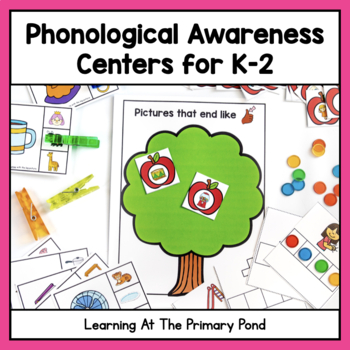
Conclusion
Your phonological awareness instruction can complement and support your phonics instruction – and that will help your students become successful readers and writers!
If you’d like a free phonics scope and sequence for Kindergarten, 1st grade, and 2nd grade, grab one for free here!
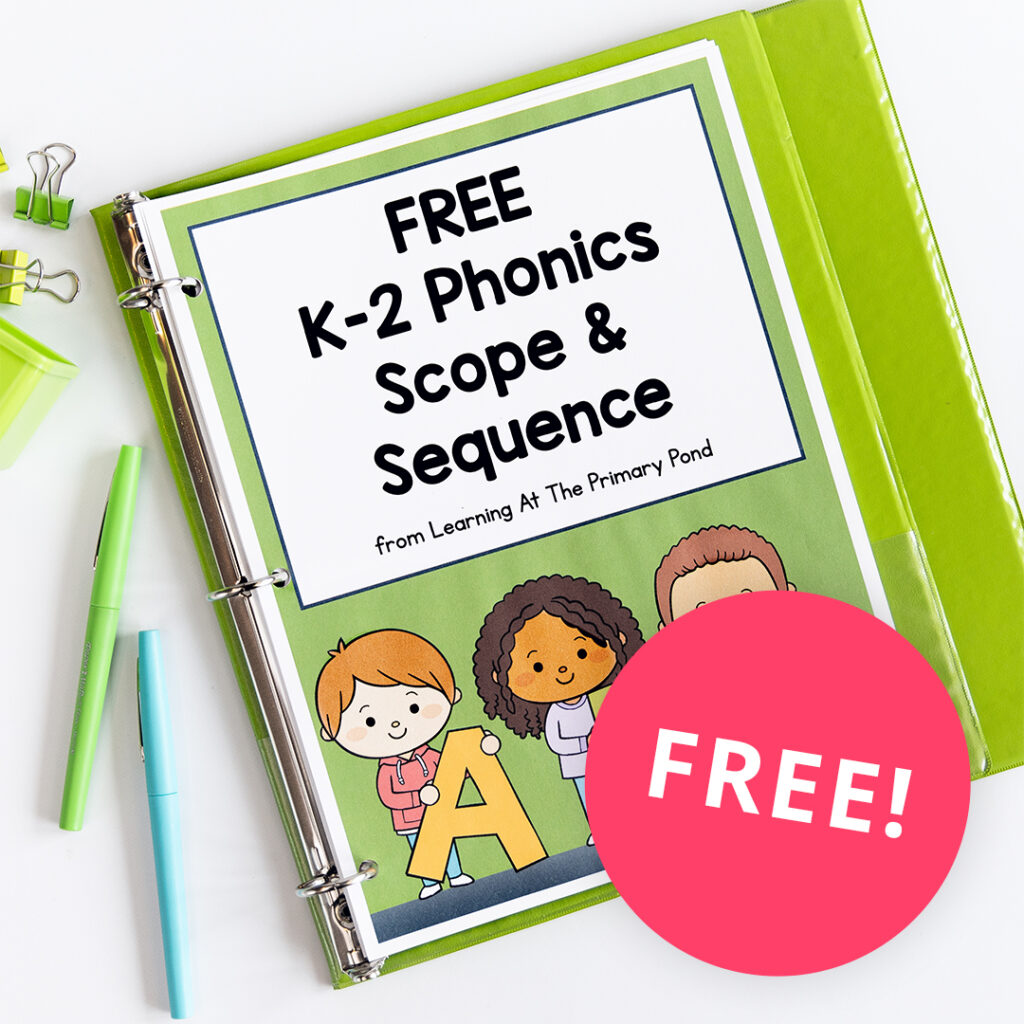
To learn more about From Sounds to Spelling, a program where phonological awareness and phonics instruction are thoughtfully integrated, visit our website here.
Happy teaching!
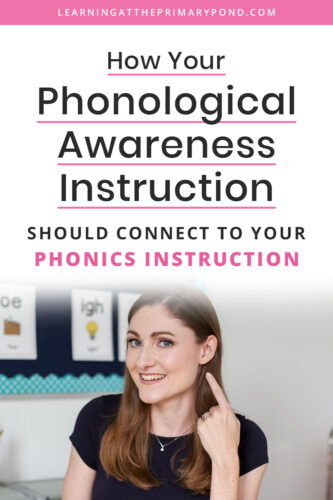

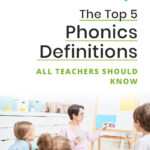


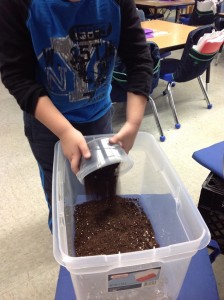

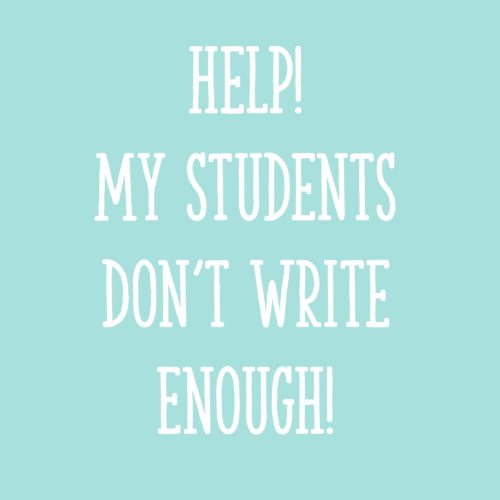






I’m not read to teach my three year old how to read, but I’m learning more about how to teach phonics. Your post reinforced what I’ve been reading and learning in a book titled “Making Sense of Phonics: The Hows and Whys” by Isabell L. Beck.
Thanks for the rec, Ka’Lon!
Great blog. Thank you for the information on why phonemic awareness and phonics are essential skills for strong readers. Phonemic Awareness is important because it is a prerequiste to being successful in phonics. Phonemic Awareness goes a long way with only 8-10 minutes of activities each day. Phonics needs to be taught systematically. It goes from easier to harder tasks.
Thanks, Joanne!
Thanks Alison for great reminders about the many reasons why we should connect our phonological awareness and phonics instruction. Your specific examples and visuals were absolutely be helpful in guiding me towards this important goal of supporting the ongoing success of our young readers and writers.
Thanks, Nancy!
Thank you for this informative blog on the importance of phonemic awareness and phonics. I agree that phonemic awareness is important and it is a prerequiste for learning phonics. CHildren need opportunities to ‘play’ with sounds, count the sounds, notice the sound in each phoneme (phonemic awareness) and then be able to write the letter for each sound they hear in a word (phonics). I like the way you broke it up and your suggestions on how to scaffold this and plan specific lessons ahead.
Thanks, Joanne!
This is great information and beneficial to the teachers I coach as well as the students I teach. We have a 30 minute block for phonics instruction and we have struggled to make the shift from one program to the SOR. It would be great to get your input on how to break that 30 minute block into a more meaning lesson incorporating the application of skills for students.
Hey there! Here’s a blog I wrote about what to teach in phonics: Phonics in K-2: What to Teach
Thank you for the reminders about connecting phonological awareness and phonics! I will be taking a closer look at my scope and sequence and phonological awareness activities now.
Absolutely!